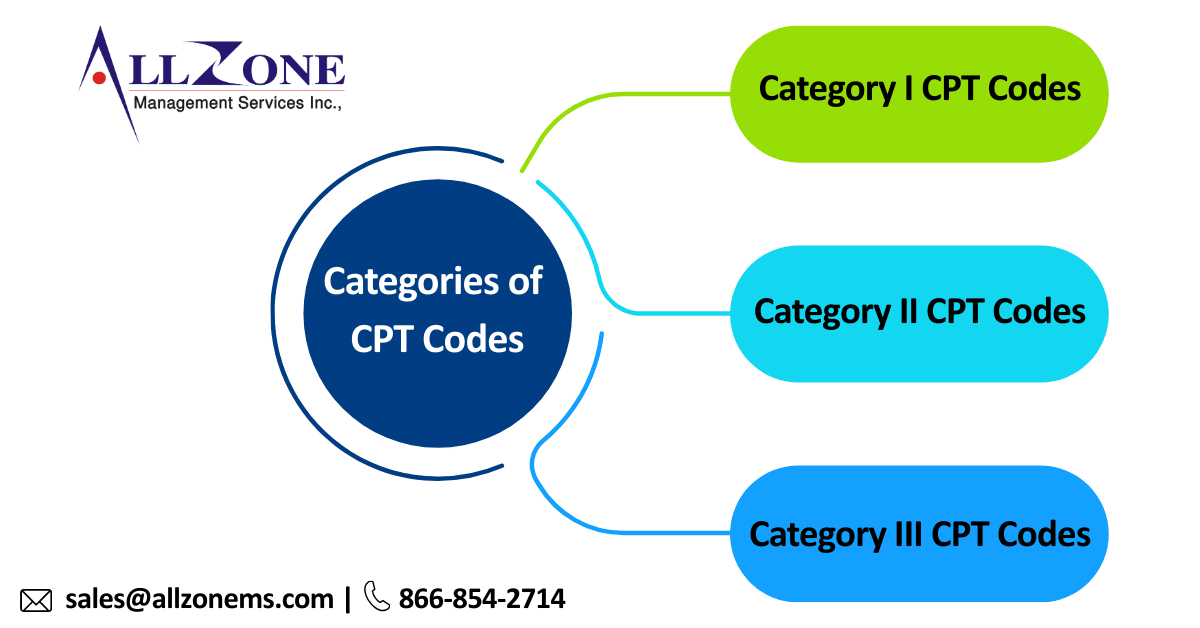Current procedural terminology meaning: Current Procedural Terminology or CPT codes are developed by the American Medical Association (AMA) to describe a wide range of healthcare services provided by physicians, hospitals, and other healthcare professionals. These codes are utilized to communicate with other physicians, hospitals, and insurers for claims processing. There are three categories of CPT Codes: Category I, Category II, and Category III.
1. Category I CPT Codes:
CPT codes are used for reporting devices and drugs (including vaccines) required for the performance of a service or procedure, services or procedures performed by physicians and other health care providers, services or procedures performed intended for clinical use, services or procedures performed according to current medical practice, and services or procedures that meet CPT requirements. These codes are billable for reimbursement.
There are 10 main sections:
| 00000-09999 | Anesthesia Services |
| 10000-19999 | Integumentary System |
| 20000-29999 | Musculoskeletal System |
| 30000-39999 | Respiratory, Cardiovascular, Hemic, and Lymphatic System |
| 40000-49999 | Digestive System |
| 50000-59999 | Urinary, Male Genital, Female Genital, Maternity Care, and Delivery System |
| 60000-69999 | Endocrine, Nervous, Eye and Ocular Adnexa, Auditory System |
| 70000-79999 | Radiology Services |
| 80000-89999 | Pathology and Laboratory Services |
| 90000-99999 | Evaluation & Management Services |
2. Category II CPT Codes:
Category II CPT Codes are used for reporting performance measures reducing the necessity for chart review and medical records abstraction.
These cpt codes provide the data needed by the Performance Measures Advisory Group (PMAG). The PMAG is comprised of performance measures experts representing the AMA, the Centers of Medicare and Medicaid Services (CMS), the Agency of Healthcare Research and Quality (AHRQ), the Joint Commission on Accreditation of Healthcare Organizations (JCAHO), the National Committee for Quality Assurance (NCQA), and the Physician Consortium for Performance Improvement. This data is used to collect information about the quality of care to help establish and improve performance measures. These codes are not billable for reimbursement.
| Composite measures | 0001F-0015F |
| Patient management | 0500F-0575F |
| Patient history | 1000F-1220F |
| Physical examination | 2000F-2050F |
| Diagnostic/screening processes or results | 3006F-3573F |
| Therapeutic, preventive or other interventions | 4000F-4306F |
| Follow-up or other outcomes | 5005F-5100F |
| Patient safety | 6005F-6045F |
| Structural Measures | 7010F-7025F |
3. Category III CPT Codes:
Category III cpt codes are used for reporting emerging technology in a number of capacities including services or procedures recently performed on humans, clinical trials and etc. These cpt codes are temporary codes and must be accepted for placement in Level I within five years, be renewed for another five years or be removed from the book.
Another feature of Category III CPT codes is that they are listed in numerical order instead of anatomical location.
Emerging Technology 0016T-0207T
- CPT Code Revisions: These cpt codes are constantly being removed, revised, updated, and added each October with the exception of emerging technology and vaccines, which are updated every six months.
- CPT Code Resources:CPT is a registered trademark of the American Medical Association and holds the copyright of the CPT coding system. Providers of service must pay a license fee to have access to these codes. However, patients and other users can register on their websites and perform up to 12 searches.
CPT Code Series and CPT Code List
CPT codes are a set of five-digit numeric codes used to describe medical procedures and services. They are used by healthcare providers to bill insurance companies for their services. CPT codes are updated annually by the American Medical Association (AMA).
There are three main categories of CPT codes:
- Evaluation and management codes describe services such as office visits, consultations, and procedures performed in a physician’s office or other outpatient setting.
- Surgery codes describe surgical procedures performed in a hospital or other outpatient setting.
- Anesthesia codes describe the administration of anesthesia during surgery or other procedures.
CPT codes are organized into a series of chapters, each of which covers a different category of services. For example, Chapter 1 covers evaluation and management codes, Chapter 2 covers surgery codes, and Chapter 3 covers anesthesia codes.
CPT codes are also organized into a list, which is known as the CPT code list.

